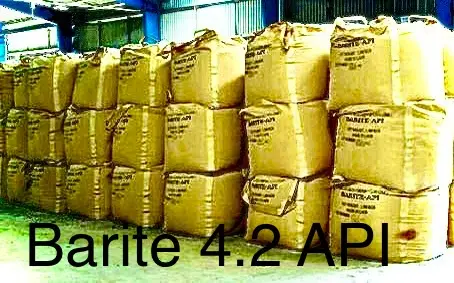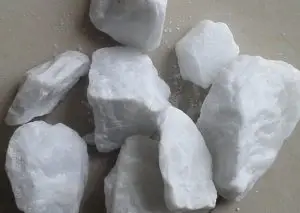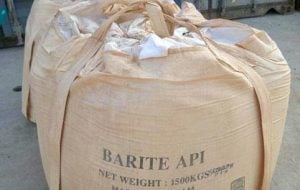
Turkey Barite supplier
- Home
- Turkey Barite supplier

Introduction to Turkey Barite for Drilling Mud
Barite plays a pivotal role in the oil and gas industry, particularly in drilling operations. When mixed with water and other additives, it forms a dense slurry known as drilling mud. This mud serves multiple purposes, including cooling the drill bit, carrying rock cuttings to the surface, and preventing formation damage.
It is typically appears as opaque, elongated crystals or as massive aggregates and commonly exhibits a range of colors, including white, colorless, gray, brown, blue, or even red, depending on impurities present in the specimen. The crystal structure of barite is often characterized by its distinct tabular or prismatic shape, with well-defined cleavage planes.
Barite 4.2
The term “barite 4.2” refers to a specific grade or type of barite with a density of 4.2 grams per cubic centimeter (g/cm³). In the oil and gas industry, barite is commonly used as a weighting agent in drilling fluids, where precise control of fluid density is crucial for wellbore stability and drilling efficiency.
Table of Contents
ToggleA density of 4.2 indicates that this grade of barite has a relatively high density, making it suitable for applications where heavier drilling fluids are required. By adding barite to the drilling mud, engineers can increase its density to counteract the pressure exerted by the formations being drilled. This helps prevent wellbore instability, fluid influx, and other drilling-related challenges.
Barite 4.2 is often preferred for its consistency and reliability in achieving the desired density levels in drilling fluids. It is widely used in both onshore and offshore drilling operations, where maintaining proper well control is paramount for safety and success.
Price of Barite
The price of Turkey barite can vary depending on several factors, including its grade, quality, market demand, and geographical location. Generally, barite prices are quoted in terms of price per ton (or price per metric ton) and can fluctuate based on supply and demand dynamics within the global market.
As of recent data, the price of barite typically ranges from $100 to $300 per ton, with prices at the lower end of the spectrum for lower-grade or less pure varieties and prices at the higher end for higher-grade or premium-quality barite. However, these prices are subject to change and may vary significantly based on market conditions, shipping costs, and other factors.
The geographical source of the barite can also influence its price, as transportation costs can vary depending on the distance from the mining site to the end-user location. Additionally, local market conditions and regulatory factors may impact pricing in specific regions.
Properties of Barite Ideal for Drilling Mud
Density
One of the most critical attributes of barite is its high specific gravity, which exceeds 4.2 g/cm³. This density is essential for balancing the hydrostatic pressure in the wellbore and preventing unexpected fluid influxes.
Chemical Inertness
Barite exhibits remarkable chemical stability, ensuring minimal reactivity with drilling fluids and formation fluids. This inert nature helps maintain the integrity of the drilling operation and prevents contamination of underground reservoirs.
Particle Size Distribution
The particle size distribution of barite particles is carefully controlled to optimize rheological properties and suspension stability. Uniform particle size distribution enhances the performance of drilling mud by reducing settling and improving pumpability.
Barite plays a crucial role in drilling operations across the oil and gas industry. Its significance stems from its unique properties that make it an indispensable component of drilling fluids, commonly known as drilling mud. Here’s a breakdown of the roll of barite in drilling:
- Density Control: One of the primary functions of barite in drilling mud is to control the density of the fluid. Barite’s high specific gravity ensures that the drilling mud maintains sufficient weight to counterbalance the pressure exerted by the surrounding formations. This prevents the influx of formation fluids into the wellbore and helps stabilize the well.
- Pressure Balance: During drilling, the hydrostatic pressure exerted by the drilling mud must exceed the pressure from the formations being drilled. Barite contributes to achieving and maintaining this pressure balance, thereby preventing blowouts and other well control issues.
- Formation Lubrication: Barite particles act as lubricants for the drill bit and the drill string as they traverse through the wellbore. This reduces frictional resistance, heat generation, and wear on drilling equipment, enhancing drilling efficiency and longevity.
- Cuttings Transport: As the drill bit penetrates the subsurface formations, it generates rock cuttings that need to be removed from the wellbore. Barite-laden drilling mud efficiently suspends and carries these cuttings to the surface, preventing them from settling and clogging the wellbore.
- Wellbore Stability: Barite helps maintain wellbore stability by forming a filter cake on the walls of the borehole. This cake acts as a barrier, preventing fluid invasion into permeable formations and minimizing formation damage.
- Rheological Properties: Barite influences the rheological properties of drilling mud, including viscosity, yield point, and gel strength. These properties affect the flow behavior and carrying capacity of the mud, ensuring optimal performance during drilling operations.
Specification of Turkey Barite for drilling
| Parameter | Specification |
|---|---|
| Specific Gravity | 4.2 g/cm³ min (3.95 – 4.30 also available) |
| BaSO4 | 90% min |
| Extractable Carbonates | 3000 mg/l max |
| Hg | 1.00 ppm max |
| Cd | 3.00 ppm max |
| Water Alkaline Earth Metals as Calcium | 250 ppm max |
| Moisture | 1.00% max |
| Lump Size | 0 to 200 mm |
| Iron Content | 1% max |
| Barite Colour | Buff, Off-White |
Packing details
The packing of barite typically involves packaging the material in bulk bags, also known as flexible intermediate bulk containers (FIBCs), or in 50-kilogram (kg) multi-wall paper bags. The choice of packing method depends on factors such as the quantity of barite being transported, the logistics involved, and the preferences of the buyer and seller.
- Bulk Bags (FIBCs): Barite is commonly packed in bulk bags, which are large, flexible containers designed to hold and transport granular or powdered materials. These bags typically have a capacity ranging from 500 kg to 1500 kg or more. Bulk bags offer advantages such as ease of handling, efficient storage, and reduced packaging waste. They are often used for large-scale shipments of barite to drilling sites or processing facilities.
- Multi-wall Paper Bags: For smaller quantities or when precise measurements are required, barite may be packed in 50 kg multi-wall paper bags. These bags are durable and can withstand the weight of the barite while providing protection against moisture and contamination. They are commonly used for retail packaging or smaller-scale shipments where bulk bags are not practical.
Density of barite
The density of barite, also known as barium sulfate (BaSO4), is a crucial characteristic that makes it valuable in various industries, particularly in the oil and gas sector. The density of barite is typically measured in grams per cubic centimeter (g/cm³) or kilograms per liter (kg/L).
The density of pure barite mineral ranges between 4.10 g/cm³ to 4.30 g/cm³. However, the density of commercially available barite used in drilling mud applications is usually standardized to be around 4.20 g/cm³. This density is significantly higher than that of water, which has a density of 1 g/cm³, and many other solids commonly found in drilling fluids.
The high density of barite is essential in drilling mud formulations because it helps achieve specific objectives:
- Hydrostatic Pressure: Barite is added to drilling mud to increase its density and create sufficient hydrostatic pressure to counteract the pressure from the formations being drilled. This prevents the influx of formation fluids into the wellbore and maintains well control.
- Formation Stabilization: The density of barite contributes to the formation of a stable filter cake on the walls of the wellbore. This cake helps prevent fluid invasion into permeable formations and minimizes wellbore instability issues.
- Cuttings Transport: Barite-laden drilling mud effectively suspends and transports rock cuttings generated during drilling operations to the surface. The high density of the mud ensures that the cuttings remain suspended, preventing them from settling and obstructing the wellbore.
- Wellbore Integrity: By maintaining adequate density, barite helps prevent wellbore collapse and maintains the integrity of the well, particularly in challenging drilling environments.
Turkey as a Barite Supplier
Turkey boasts abundant reserves of high-quality barite, making it a key player in the global market for drilling mud additives. The country’s strategic location, coupled with its advanced mining infrastructure, positions it as a reliable supplier to major oil and gas companies worldwide.
Abundance of Barite Deposits
Turkey is home to vast deposits of barite, primarily located in regions such as Anatolia and Thrace. These reserves are characterized by their high purity and favorable geological conditions, facilitating cost-effective extraction and processing.
Quality Standards
Turkish barite suppliers adhere to stringent quality standards to meet the specifications of discerning customers in the oil and gas industry. Rigorous testing ensures that the barite meets required particle size distribution, density, and chemical composition criteria, guaranteeing its suitability for drilling mud applications.
Advantages of Using Turkish Barite for Drilling Mud
Cost-effectiveness
The proximity of Turkish barite mines to major drilling sites translates into reduced transportation costs for end-users. Additionally, competitive pricing and economies of scale contribute to the cost-effectiveness of sourcing barite from Turkey.
Environmental Considerations
Turkey’s commitment to sustainable mining practices aligns with the growing emphasis on environmental stewardship in the oil and gas sector. By adhering to strict environmental regulations and implementing responsible mining techniques, Turkish barite suppliers minimize ecological impact while meeting industry demand.
Challenges and Solutions
Transportation Logistics
Despite its abundance, transporting barite from remote mining locations to end-user facilities poses logistical challenges. However, efficient supply chain management and strategic partnerships with logistics providers help mitigate these challenges, ensuring timely delivery to customers worldwide.
Regulatory Compliance
Compliance with international standards and regulations is paramount for Turkish barite suppliers seeking to access global markets. By adhering to industry-specific certifications and quality control protocols, suppliers demonstrate their commitment to product excellence and customer satisfaction.
Future Outlook
The demand for barite as a drilling mud additive is expected to continue growing in tandem with the expansion of the global oil and gas industry. Turkish suppliers are well-positioned to capitalize on this trend, leveraging their expertise and resources to meet evolving market needs.
Conclusion
Turkey stands out as a reliable source of high-quality barite for drilling mud applications. With its abundant reserves, adherence to stringent quality standards, and commitment to sustainability, Turkey offers a compelling value proposition to oil and gas companies worldwide.
FAQs
- Is Turkish barite suitable for all types of drilling operations?
- Yes, Turkish barite meets the requirements of various drilling applications, including onshore and offshore projects.
- How does the quality of Turkish barite compare to other sources?
- Turkish barite is renowned for its high purity and consistent quality, making it a preferred choice for discerning customers in the oil and gas industry.
- Are there any environmental concerns associated with barite mining in Turkey?
- Turkish barite suppliers prioritize environmental sustainability and employ responsible mining practices to minimize ecological impact.
- What factors contribute to the cost-effectiveness of sourcing barite from Turkey?
- Proximity to drilling sites, competitive pricing, and efficient supply chain management contribute to the cost-effectiveness of Turkish barite.
- How can I ensure that the Turkish barite I purchase meets industry standards?
- Look for suppliers that adhere to recognized quality certifications and conduct thorough testing to verify compliance.
Contact Info
Turkey office:No.6 of Fahrettin Pasa Sokak , Galip Erdem steet, Ilkbahar Mah. Turan Gunes Ave. Çankaya Ankara
Phone: 00903125147055
Dubai office: 3509 of the Burligton tower, business bay, dubai-uae
Phone:0097142369830
E-Mail: [email protected]


